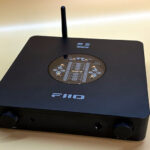Blog
FiiO K13 R2R Review — Headfonics

Meldrick reviews the FiiO K13 R2R, a new desktop 24-BIT R2R DAC and 2.4W-capable headphone amplifier with LDAC Wireless compatibility. It is currently priced at $319.99.
Disclaimer: I received this sample in exchange for my honest opinion. Headfonics is an independent website with no affiliate links or services. I want to thank FiiO for their support.
You can click here to learn more about the FiiO audio products previously reviewed on Headfonics.
This post follows our current scoring guidelines, which you can read in more detail here.
FiiO needs little to no introduction within the DAC/AMP space, especially with their previous K11 and K11 R2R desktop units. Today, the brand is expanding its lineup with the K13 R2R, its latest all-in-one, affordable, wireless-capable DAC and headphone amplifier.
Coming in at $319, the K13 R2R comes with Bluetooth 5.4 connectivity, balanced XLR outputs, and a comprehensive 10-band parametric EQ, making it a compelling desktop audio solution on paper
To see if the K13 R2R delivers on its promise of providing improved R2R warmth in a feature-complete desktop centerpiece, and how it competes against the Shanling EH2 and the Fosi K7, read my full review below.
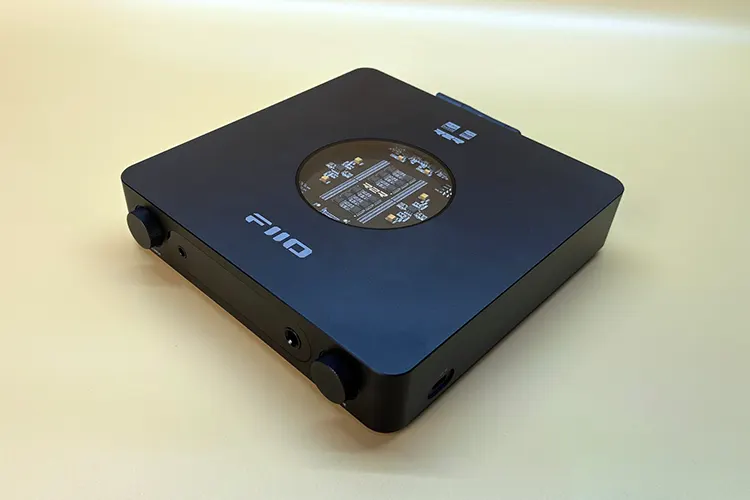

Features
The FiiO K13 R2R employs a proprietary 24-bit R2R resistor array architecture similar to the K11 R2R, featuring 192 precision thin-film resistors arranged across four channels with 0.1% accuracy and ultra-low 3 ppm temperature drift.
FiiO claims this delivers an analog-like sound signature that R2R implementations are celebrated for, making high-end multibit conversion accessible at an unprecedented price point.
The unit’s fully balanced amplifier section utilizes dual OPA1642 and dual TPA6120A2 chips, delivering up to 2400mW per channel at 32Ω through its 4.4mm balanced output and 600mW at 32Ω via the 6.35mm single-ended jack, a significant boost over its predecessor
One of the K13 R2R’s standout features is its sophisticated 10-band parametric EQ system, accessible via the FiiO Control app or web interface.
Unlike simple bass/treble controls, this PEQ offers precise frequency-specific adjustments with cloud-based headphone correction profiles, allowing users to compensate for headphone response characteristics or apply vintage tuning curves.
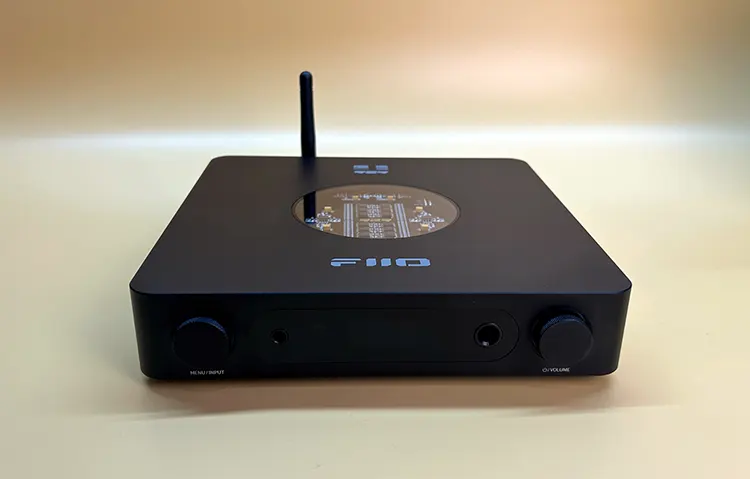

Design
The K13 R2R adopts a substantially larger footprint compared to the compact K11 R2R, measuring approximately 7.5 inches square. This increased size accommodates the internal 30W switching power supply and enhanced circuitry while maintaining a desktop-friendly low profile.
The unit features a unibody CNC-machined aluminum chassis that comes in either a black or silver anodized finish. The unit received by Headfonics is of the black variety, and its finish provided good scratch and fingerprint resistance during my testing.
Unlike many minimalist desktop DACs, the K13 R2R incorporates a distinctive “skylight” design, a circular glass window on the top panel that showcases the internal R2R resistor array.
As someone who’s reviewed numerous monolithic pieces of desktop audio equipment, any amount of visual flair is already a big plus. But the inner gearhead in me can’t help but appreciate how FiiO thoughtfully laid out their resistor ladder on the PCB with aesthetics in mind.
The right side of the unit houses a singular USB-C input for ease of connection, while the majority of the unit’s I/O options can be found on the rear of the unit.
The front panel maintains FiiO’s signature clean aesthetic, with two knurled aluminum knobs flanking a 1.5-inch monochrome OLED display.
The left knob controls source and menu selection, while the right knob handles volume adjustment and power. Both knobs feature tactile detents and smooth rotation with distinct stops, as well as RGB addressable LEDs.
Overall build quality feels substantial and premium, while it has significantly more flair than its predecessor, its cubic silhouette and aluminum shell still let it easily fit in aesthetically in any desk or audio setup.
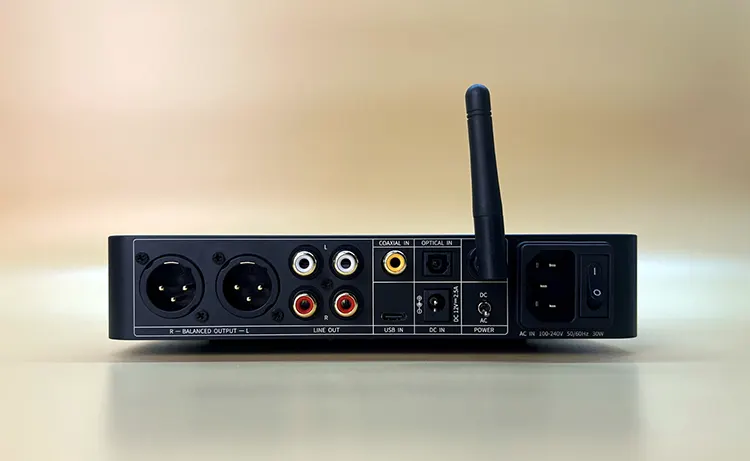

I/O
The K13 R2R offers comprehensive connectivity options that address many limitations of its predecessor. Digital inputs include dual USB-C inputs, coaxial, optical, and Bluetooth 5.4, ensuring compatibility with a wide range of source devices.
The USB-C input utilizes an XMOS XU316 receiver supporting PCM audio up to 384kHz/32-bit and native DSD256 with full MOQ decoding, providing comprehensive playback capabilities.
The additional USB-C port on the side panel is a great touch as well. Offering convenient connectivity for smartphones and tablets, this was my preferred port when connecting to my work laptop as well.
After using the K13 R2R, I couldn’t help but think why it took so long for a DAC/AMP brand to implement this feature.
A significant addition is Bluetooth 5.4 wireless connectivity with support for LDAC, AAC, and SBC codecs. The included antenna ensures reliable wireless performance and connects to my different phones, tablets, and laptops without any issues
For outputs, the K13 R2R provides both 6.35mm single-ended and 4.4mm balanced headphone jacks on the front panel. The rear panel features switchable RCA outputs that can operate in either fixed line-out or variable pre-out modes, as well as balanced XLR outputs.
The inclusion of balanced XLR outputs significantly expands the K13 R2R’s utility, enabling direct connection to high-end power amplifiers or active monitors without the need for RCA-to-XLR adapters.
Another unique feature of the K13 R2R is its ability to be powered via the internal 30W power supply or an external DC power supply.
The DC barrel jack at the back of the unit makes it compatible with higher-end linear power supplies, and switching between DC and AC powering modes is done via the toggle switch beside the AC input port.
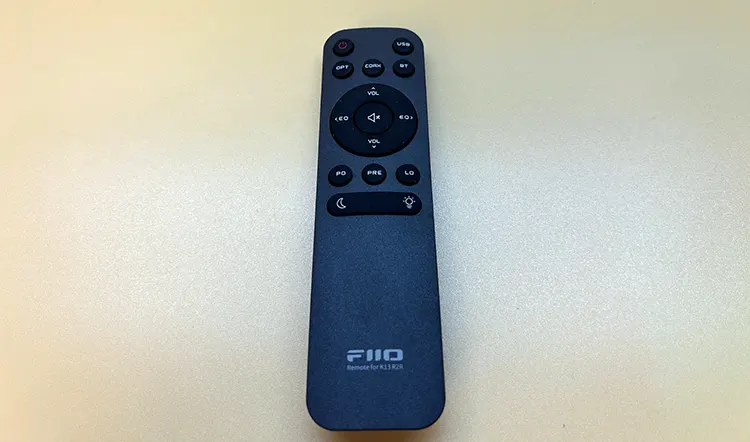

Controls
The K13 R2R maintains an intuitive, straightforward control interface despite its extensive feature set.
The left rotary encoder handles input selection and menu navigation, while the right volume knob handles volume control. Both knobs are digital rotary encoders and are endlessly with distinct stops between each step.
The OLED display provides clear, at-a-glance information including volume, sample rate, gain level, and output mode. The display is well-sized and easily readable from typical desktop viewing distances.
Unlike units with complex button arrays, the K13 R2R relies primarily on its two encoders for operation. A short press on the input selector cycles through available sources, while a long press accesses the settings menu, where users can select between 3 gain levels, adjust RGB lighting, enable sleep timer, and configure other parameters.
I appreciated how each gain setting had independent volume memory, which came in quite handy while I was testing both IEMs and Headphones
The NOS/OS (Non-Oversampling/Oversampling) mode can also be toggled via the menu, allowing users to choose between the more organic, analog-like NOS presentation or the cleaner, more precise OS mode depending on preference.
The volume encoder also includes a push-to-dim function, turning off the OLED display after a quick press. This was quite useful during nighttime listening, wherein I didn’t need the information display during simple casual listening
An infrared remote control is included, offering basic playback control and volume adjustment from across the room. While not essential for desk use, the remote proves valuable when using the K13 R2R as a pre-amp in a living room system.
When I had the K13 R2R on my nightstand for my bedside listening setup, I found the remote to be quite useful as I didn’t need to pick up my phone for simple controls.
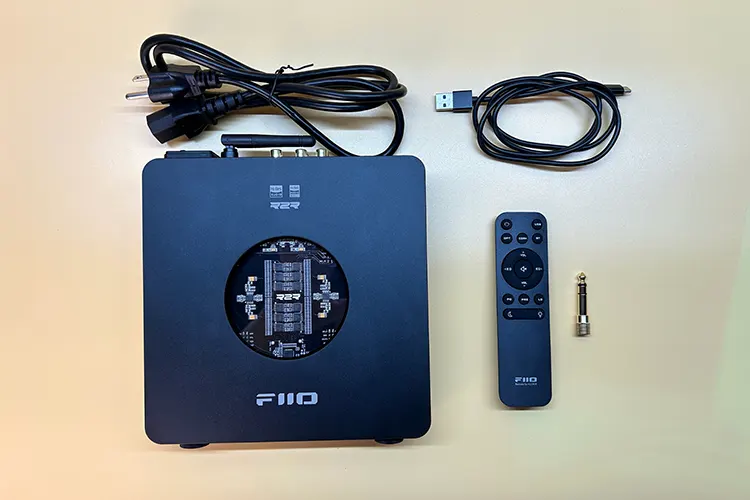

Packaging & Accessories
The K13 R2R arrives in professional packaging with a picture of the unit displayed up front. Inside, the unit is well-protected by dense foam inserts that prevent movement during shipping.
Included accessories comprise a USB-C to USB-A cable for computer connection, the Bluetooth antenna, an infrared remote control, a 3.5mm to 6.35mm adapter, and a detailed user manual covering setup and operation.
The K13 R2R’s internal PSU simply requires a standard IEC power cable (included) for operation. This streamlined approach reduces cable clutter and eliminates concerns about power supply quality, though it prevents easy upgrading to linear power unless using the optional DC input.
Sound Impressions
The following sound impressions were made with the Sennheiser HD 600, HarmonicDyne BAROQUE, Audio-Technica R70X, Mod House Argon Mk3, and MOONDROP Blessing 3 as my main headphone and IEM pairings.
Unless otherwise specified, all tests and comparisons on the K13 R2R were completed in NOS mode and with the PEQ disabled at its neutral position.
NOS vs OS
The K13 R2R’s NOS mode delivers a warmer sound signature that slightly smoothens some finer details. The presentation features softer transients and a relaxed treble that reduces listening fatigue while maintaining excellent tonal density.
Soundstage in NOS mode feels expansive and atmospheric, with instruments positioned in a natural, spacious environment. However, micro-detail can seem slightly compressed compared to more analytical sources.
OS mode shifts the sound signature to a cleaner and more precise tonality, with tighter sub-bass control and more treble extension.
Imaging becomes slightly more defined, with improved instrument separation and spatial accuracy, though the soundstage narrows slightly and becomes more intimate.
For most of my listening with funk, disco, and acoustic tracks, I gravitated toward NOS mode. The warmth and natural flow made extended listening sessions effortless and fatigue-free.
With more complex electronic productions and Hip-Hop, OS mode proved to be more appropriate, highlighting deeper sub-bass hits and better extended cymbal strikes.
The difference between modes is minimal yet substantial enough to effectively offer two distinct sonic personalities.
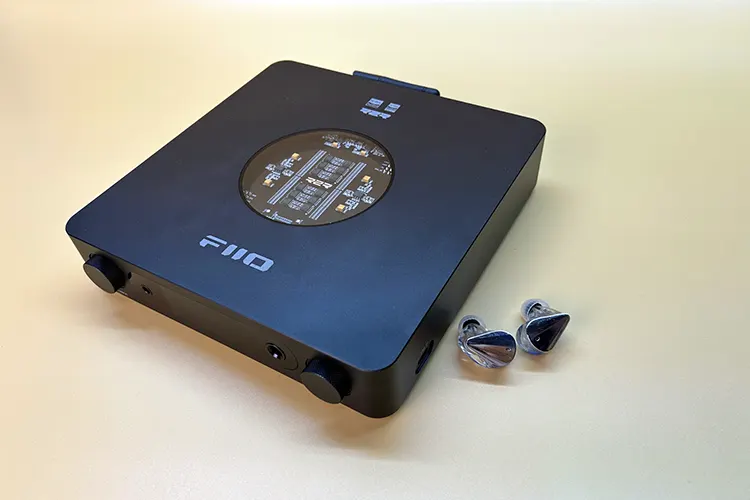

Bass
The K13 R2R’s sound signature leans more towards the warmer side, but its sub-bass is still presented with excellent texture and natural weight, never coming off as bloated or boomy. Sub-bass extension reaches deep without overwhelming with excessive bass quantity.
Mid-bass carries a slight warmth that enhances the organic quality of acoustic instruments. Double bass and bass guitar exhibit excellent note definition. What immediately struck me was how detailed each strum was, even on the NOS setting.
On other R2R DACs, I found that the NOS setting had better note weight and tuning while sacrificing some detail and texture, but the K13 managed to fuse the best of both configurations.
In tracks with prominent kick drums and synthesized bass, the K13 R2R delivered impressive dynamics and layering.
Percussive instruments are a standout with the K13 R2R, coming off with realistic harmonics and texture, without overdoing their presentation or drowning out the mix.
The warmth never muddied complex basslines, maintaining clarity between sub-bass rumble and mid-bass punch; however, the overall warmer presentation did leak into the midrange.
Mids
The K13 R2R has a clean and organic-sounding midrange that leans slightly towards the warm side. Male vocals possess exceptional weight and authority, with chest resonance and lower harmonics beautifully rendered.
Female vocals benefit from the smooth upper midrange tuning, avoiding any hint of harshness or sibilance even with bright recordings. There’s a touch of warmth that adds body to thinner voices without creating excessive thickness.
However, compared to more neutral or colder sources, they have a less airy presentation that may come off as being less detailed to some.
String instruments show a similar trend; they are presented with more note weight and in a more relaxing tonality, but they do not have the same detail level compared to colder sources. This becomes evident in tracks with predominant use of electric keys within the mix.
Horn sections and brass instruments particularly excel with the K13 R2R’s tonal balance, projecting with appropriate bite and brashness while avoiding shrillness.
Jazz and funk recordings sound vibrant and engaging, with instruments occupying their proper space in the soundstage.
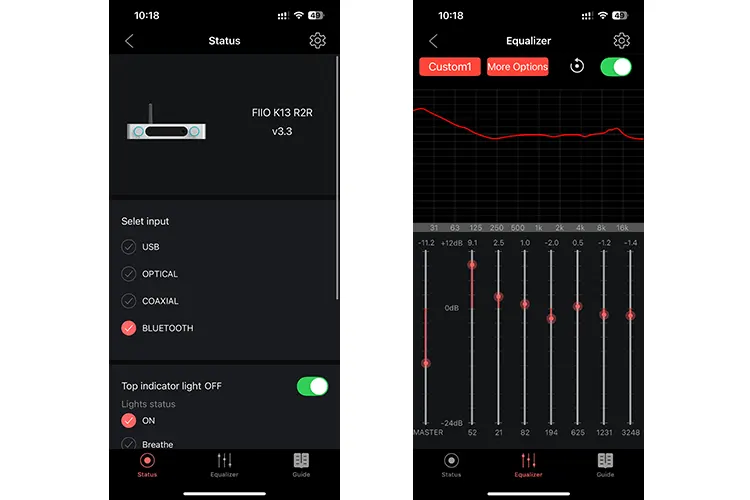

Treble
Treble presentation leans toward smoothness rather than sparkle and micro-detail. This tuning proves ideal for extended listening sessions and brighter headphones that benefit from smoothing.
Cymbal crashes and hi-hats possess good body and shimmer without becoming too sibilant. There’s sufficient detail retrieval to appreciate production nuances, though the presentation prioritizes naturalness over analytical precision.
Higher-frequency harmonic content is slightly recessed compared to neutral sources, giving recordings a slightly darker background. This characteristic proves beneficial with less-than-perfect recordings, smoothing over harshness and grain.
For those seeking more treble energy, OS mode provides noticeable lift in the upper frequencies, though it still falls short of truly analytical sources.
Staging & Dynamics
Soundstage width in NOS mode impresses by balancing a wide sense of atmosphere without being too exaggerated, creating a convincing sense of acoustic space that feels like being in a room with the performers
While not being overly wide, it has good 360-degree directionality and height. I found that the K13 R2R was better than most sources I’ve tried in placing instruments or accents towards the upper left and upper right regions of the soundscape.
Imaging accuracy falls slightly behind the more neutral sources like the Topping L30II, but its imaging performance is a big step up from other R2R-based DAC/AMPs like the K11 R2R.
Dynamics are a particular strength, with the K13 R2R delivering impressive contrast between the softest and loudest instruments within complex mixes.
Click on page 2 below for my recommended pairings and selected comparisons.

